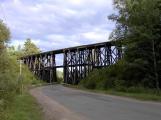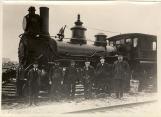1
The Salisbury-Albert RailwayDuring the nineteenth century there was a need for a railway to link the mines in Albert Mines, the gypsum mill in Hillsborough, and the oil fields of Stoney Creek with the main railway line in Salisbury. During the winter months the Petitcodiac River would fill with winter ice making it impossible to transport by ship any of the valuable minerals mined in the area. The only solution was to build a railway to provide year round transportation. The Hon. C. A. Peck was elected to the House of Assembly in Fredericton following Confederation in 1867, and he soon began to press to get a railroad built in Albert County. Finally in 1875, a grant was given to Thomas McHenry, Hon. John Lewis, and others for the building and operation of a railway to Riverside-Albert from Salisbury. The firm of McDonald and Co. was awarded a contract for the building of the railway. Construction started in 1875, but the McDonald and Co. firm soon stopped construction and gave up the contract. The railway was then completed in 1876 by another firm. In 1888, the railway was foreclosed by the English bond-holders who had put up most of the money to build the railway. The railway was ordered to be sold and a man from New York, C. H.. Harman, who owned a manganese mine in Dawson Settlement, Albert County bought the railway for $50,000. He wanted to ensure that there would be year round transportation available for materials mined in the area. In 1900 Abram Sherwood became the railway manager, he managed the railway until 1913. Mr. Sherwood's good business skills soon had the railway operating with average yearly earnings of between $17,000 to $25,000. The railroad was taken over by the Government in 1911 and made part of the Canadian National Railway.
4
The Hon. Gaius Turner wanted to build an extension of the railway from Albert to Harvey because of the need to bring supplies to his shipyard in Harvey. In 1880 he received a $9,000 grant from the government to begin construction of the three mile extension from Albert to Harvey. In1884 he was made president of the Albert to Harvey branch of the railway. Turner then began to lobby to have an extension of the line built to Alma in order to give the shipbuilding and lumbering companies in that area access to the railway. There were many obstacles to overcome in the building of this railway, including a steep grade which made it difficult to get the trains to climb up the hills on this part of the line, and sometimes dangerous to come down them. Mr. Turner finally got a grant of $48,500 from the government and went ahead with construction even though this was not enough money to finish the railway. Without further guarantees of subsidies and because there was insufficient passengers and commercial traffic on the line it went bankrupt after several years of operation. It was easier and cheaper for industry in the area to ship their goods by water. Unlike Hillsborough which needed year round transportation to ship plaster from the mill, the major export from the Alma area was timber which was harvested in the winter and not shipped until spring. Hence there was not much demand to ship goods in the winter so it didn't matter if the harbours in the Alma area were full of ice in the winter. Although the railway was popular for excursions back and forth to Alma there was not enough passenger traffic to keep the line operating. The line from Harvey to Alma was closed only four years after it was opened and the rails were taken up to pay off the railways debts. The line from Albert to Harvey was closed in 1894 after the railway bridge over the Shepody River collapsed. The engine had just crossed over to the Albert side of the bridge when the bridge collapsed.5
Remains of the Shepody River Railway Bridge following the collapsed of the bridge on June 30th 1894.1 July 1894
Albert, New Brunswick, Canada
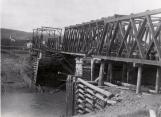
6
Both the mail & passenger cars plunged 30 feet into the river, fortunately the tide was out and so there was only a few feet of water in the river. Otherwise someone might have been trapped in one of the cars and may have drowned. Thankfully no one was killed, only shaken-up, including Miss Coonan who was knocked unconscious. This accident happened on June 28th when there were only 7 passengers and the crew on board the train. The accident could have been a lot worse if it had happened a few days later on Dominion Day, July 1st, when a special excursion train of up to 400 passengers was scheduled to cross over that same bridge. After the accident conductor Archibald Downing re-entered the water-filled mail car to retrieve a mail package containing one thousand dollars.7
This railway car was destoryed when the Shepody River railway bridge collapsed on June 30th 1894.1 July 1894
Albert, New Brunswick, Canada
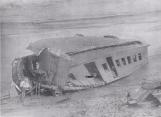
8
The railway line from Salisbury to Albert also faced many difficulties during this same period. The train shops in Moncton refused to return an engine which had been sent to the shops for repairs, until the $1000 bill for repairs to the train was paid in full. The railway did not have enough money to pay the bill so Mr. Sherwood stepped in and gave the shops a personal cheque for $1000 to cover the cost of the repairs. In 1896, an axle broke on one of the engines. Rather than wait until another axle could arrive from Moncton, the engineer decided to set out with only the one axle driving the train. The train got only 8 miles out of Salisbury when the second axle also broke. The crew made a trip of 16 miles, by handcar, to Hillsborough in order to get an old set of wheels stored in the shed at the railway station. However, those wheels were found to be useless and they decided instead to use the wheels from the spare engine. The spare engine was jacked up and the wheels removed, then at eight o'clock at night the wheels were loaded into a horse drawn cart, and hauled back towards Salisbury. The trip was a long and slow one. The horse had to stop several times to rest from pulling the heavy load, and the crew had to un-hitch the cart several times and drag the wheels by hand over several culverts. As daylight broke the tired horse and crew finally arrived back at the train with the replacement wheels. Two hours later the new wheels were in place and the passengers once again boarded the train heading towards Hillsborough. When the train finally pulled into the station in Hillsborough it was a total of 23 hours late.Another incident occurred when the railway trestle at Turtle creek burned in 1903, while both engines were on the Albert side of the trestle. With no engine available on the Salisbury side of the trestle Mr. Sherwood decided to hire teams of horses to move passengers and mail back and forth the rest of the way from the trestle to Salisbury. Mr. Sherwood then decided to move the engine of lesser value to the other side of the trestle. He was told that moving the engine would be impossible, however, his hard working crew managed to move the engine through fields, up a hill, over a highway bridge and onto the railway tracks on the other side. They ran the two engines like this for five months until a new trestle was built.
The line from Albert to Hillsborough was closed in 1955. The rest of the line from Hillsborough to Salisbury closed in 1981. By this time modern highways through the County and the rest of the Province had made transporting goods by truck much faster than transporting goods by train. At the same time several of the local companies which had used the railway to transport their products to market, like the plaster mill in Hillsborough, had gone out of business. In addition, passenger traffic dropped because most people now owned their own cars and it was easier and faster for them to drive to their destinations rather than take the train. Several years later the railway was turned into the Salem & Hillsborough Railway Museum.
9
The Salem and Hillsborough Railway Museum in Hillsborough.15 September 2003
Hillsborough, New Brunswick, Canada
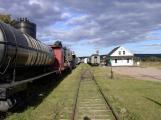
10
The Salem and Hillsborough Railway trestle in Dawson Settlement.15 September 2003
Dawson Settlement, New Brunswick, Canada
